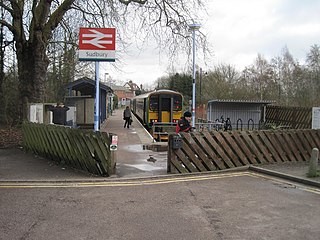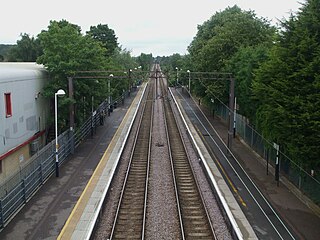
The Great Eastern Main Line is a 114.5-mile (184.3 km) major railway line on the British railway system which connects Liverpool Street station in central London with destinations in east London and the East of England, including Shenfield, Chelmsford, Colchester, Ipswich and Norwich. Its numerous branches also connect the main line to Southminster, Braintree, Sudbury, Harwich and a number of coastal towns including Southend-on-Sea, Clacton-on-Sea, Walton-on-the-Naze and Lowestoft.
The Eastern Counties Railway (ECR) was an English railway company incorporated in 1836 intended to link London with Ipswich via Colchester, and then extend to Norwich and Yarmouth.

The Great Eastern Railway (GER) was a pre-grouping British railway company, whose main line linked London Liverpool Street to Norwich and which had other lines through East Anglia. The company was grouped into the London and North Eastern Railway in 1923.

Ipswich railway station is on the Great Eastern Main Line in the East of England, serving the town of Ipswich, Suffolk. It is 68 miles 59 chains (110.6 km) down the line from London Liverpool Street and, on the main line, it is situated between Manningtree to the south and Needham Market to the north.

Cambridge railway station is the principal station serving the city of Cambridge in the east of England. It stands at the end of Station Road, 1 mile (1.6 km) south-east of the city centre. It is the northern terminus of the West Anglia Main Line, 55 miles 52 chains (89.6 km) down the line from London Liverpool Street, the southern terminus.

The Eastern Union Railway (EUR) was an English railway company, at first built from Colchester to Ipswich; it opened in 1846. It was proposed when the earlier Eastern Counties Railway failed to make its promised line from Colchester to Norwich. The businessman John Chevallier Cobbold and the engineer Peter Bruff were prominent in launching the company. The allied but nominally independent Ipswich and Bury Railway built a line onwards to Bury St Edmunds, also opening in 1846, and soon amalgamated with the EUR.

The Ipswich–Ely line is a railway line linking East Anglia to the English Midlands via Ely. There is also a branch line to Cambridge. Passenger services are operated by Greater Anglia. It is a part of Network Rail Strategic Route 5, SRS 05.07, 05.08 and part of SRS 07.03. The line has previously been part of the Great Eastern Main Line.

Stowmarket railway station is a stop on the Great Eastern Main Line (GEML) in the East of England, serving the market town of Stowmarket, Suffolk. The station is 80 miles 9 chains (128.9 km) down the line from London Liverpool Street; it is situated between Needham Market to the south and Diss to the north. It is also the junction where the Ipswich to Ely Line joins the GEML. Its three-letter station code is SMK. The station is operated by Greater Anglia, which also runs all trains that serve the station.

Sudbury railway station is the northern terminus of the Gainsborough Line, a branch off the Great Eastern Main Line in the East of England, serving the town of Sudbury, Suffolk. It is 11 miles 67 chains (19.05 km) down the line from the southern terminus of Marks Tey and 58 miles 32 chains (93.99 km) measured from London Liverpool Street; the preceding station on the branch is Bures. Its three-letter station code is SUY. The platform has an operational length for two-coach trains.

Harwich International railway station is a railway station on the Mayflower Line, a branch of the Great Eastern Main Line, the station serves Harwich International Port in Essex, England. It is 68 miles 72 chains (110.88 km) from London Liverpool Street, between Wrabness to the west and Dovercourt to the east. Its three-letter station code, HPQ, derives from its original name, Harwich Parkeston Quay.

Bury St Edmunds railway station serves the town of Bury St Edmunds in Suffolk, England. The station is on the Ipswich–Ely line and all trains calling there are operated by Greater Anglia.

Elmswell serves the village of Elmswell in Suffolk, England. It is on the Ipswich–Ely line. The station, and all trains serving it, are today operated by Greater Anglia.

The GER Class T26 was a class of one hundred 2-4-0 steam tender locomotives designed by James Holden for the Great Eastern Railway. At the 1923 grouping they all passed to the London and North Eastern Railway, who classified them E4. Eighteen survived into British Railways ownership in 1948, and the last was withdrawn in 1959, making them the last 2-4-0 tender locomotives at work in Britain. Their BR numbers were 62780–62797.

The Chingford branch line is a railway line between Clapton Junction and Chingford station. Services run between Liverpool Street station and Chingford, and are operated by London Overground. The branch is part of the Lea Valley Lines.
The Stour Valley Railway is a partially closed railway line that ran between Shelford, near Cambridge, and Marks Tey in Essex, England. The line opened in sections between 1849 and 1865. The route from Shelford to Sudbury closed on 6 March 1967 leaving only the section from Sudbury to Marks Tey, known as the Gainsborough Line, in operation.

Haughley railway station was located in Haughley, Suffolk on the Great Eastern Main Line between Liverpool Street Station and Norwich. It opened on 2 July 1849 named Haughley Junction and was a replacement for a station named Haughley Road which had been in service from 1846 to 1849 at location TM 02981 63319 on the line to Elmswell.

Bentley railway station, also known as Bentley Junction between 1849 and 1878, was located in Bentley, Suffolk on the Great Eastern Main Line. It opened in 1846 and became a junction in 1847 when the Hadleigh Railway opened. The station was closed in 1966.
The Hadleigh Railway was a 7+1⁄2-mile (12.1 km) long single track branch railway line in Suffolk, England, that connected Hadleigh to the main line railway network at Bentley Junction. It was built by the nominally independent Eastern Union and Hadleigh Junction Railway company and opened in 1847. By the time of opening it had been taken over by the larger Eastern Union Railway.
The Enfield Town branch is a branch of the Lea Valley Lines, running from Enfield Town to the West Anglia Main Line at Hackney Downs. It is a combination of the original Enfield branch built by the Eastern Counties Railway (ECR) in 1849 and a later line built by the Great Eastern Railway (GER) from Hackney Downs to Edmonton in 1872. The line is currently a double-tracked suburban railway with services running between Liverpool Street station and Enfield Town as well as services running from Liverpool Street to Cheshunt via the Southbury Loop. Part of the original branch is closed and little visible remains today.
Colchester engine shed was a motive power depot located in Colchester in the county of Essex in the UK. The original depot dated back to the opening of the Eastern Counties Railway (ECR) in 1843 and a second engine shed was built following the opening of the Eastern Union Railway in 1846. The ECR shed closed and the EUR shed was in use until November 1959 when the line was electrified and Colchester station rebuilt. A smaller two track engine shed was provided south of the station and after closure in the 1990s it was used for the stabling of diesel and electrical multiple units. It is currently known as Colchester Carriage Servicing Depot and units can be washed externally and cleaned internally on site.















